Companies are trying to navigate the digital environment. A comprehensive understanding of the implications and opportunities of digital transformation in transportation is essential. This blog provides a deep dive into the underlying impact of digital transformation on transportation, revealing dominant patterns and a wide range of potential benefits. It also analyzes how the transportation industry interacts with digital supply chain transformation and certain dynamics. If you want to learn about digital transformation in transportation and understand the broader scope of digital transformation in the supply chain, this article is for you.
Embracing Digital Transformation in Transportation and Supply Chain
In a rapidly evolving digital technology environment, industries around the world are undergoing fundamental changes that go beyond traditional standards, transforming processes, products, and business models. At the heart of this evolution is the concept of digital transformation - a complex trend that is redefining how companies generate value with existing and emerging digital tools.
As companies rush to transition to a digital landscape, understanding the implications and opportunities associated with digital transformation in transportation becomes critical. This shift has led to significant changes in the logistics and transportation sector, significantly impacting overall supply chain operations.
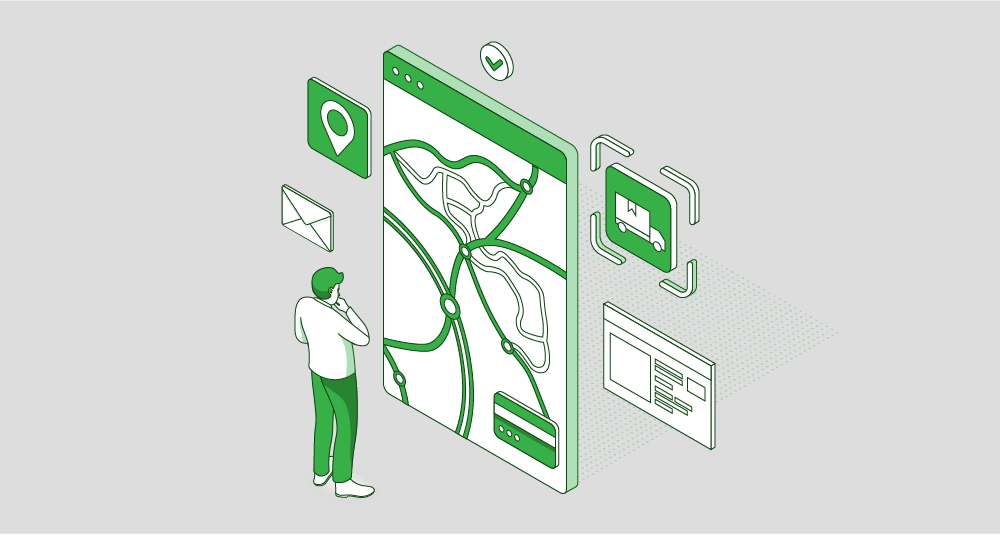
The Scope of Digital Transformation in Transportation
Digital transformation has brought significant changes to the transportation industry; it has transformed various aspects of how transportation works. Here are some key areas where digital transformation has made a substantial impact:
Predictive analytics
Advanced data analytics helps predict demand patterns and optimize routes, making transportation services and supply chains more efficient. [1]
Automation and robotics
Automation technologies such as autonomous vehicles and automated warehouses have transformed transportation operations, making them more efficient and cost-effective. [1]
IoT and telematics
Internet of Things (IoT) devices and telematics systems provide real-time monitoring and tracking of vehicles, improving visibility and maintenance. [1, 2]
E-commerce Integration
Digital platforms enable seamless order processing, inventory management, and delivery tracking, meeting the demands of the growing e-commerce sector.
Digital platforms
Online platforms connect transportation providers, shippers, and customers, facilitating efficient freight management and reducing empty trips. [1]
Cloud solutions
Cloud computing enables easy access to data and transportation services, supporting collaboration and flexibility. [1]
Artificial intelligence
Artificial intelligence-based algorithms optimize routes, resource allocation, and transportation management, increasing operational efficiency. [1]
Intelligent fleet management
IoT sensors and RFID technology in vehicles help monitor fuel consumption, maintenance needs, and driver behavior. [1]
Sustainability management initiatives
Digital tools help optimize transportation routes, reduce fuel consumption, and promote environmentally friendly practices. [1]
Real-time visibility
Real-time tracking tools allow stakeholders to monitor shipment movement and respond quickly to any disruptions. [1]
Collaborative networks
Digital platforms encourage collaboration among different players in the transportation ecosystem, improving coordination and responsiveness. [1]
Digital documentation
Electronic documentation and digital signatures streamline administrative tasks, reducing paperwork and increasing efficiency.
Data security
Digital change requires robust cybersecurity measures to protect sensitive transportation data from potential threats.
Mobile apps
Mobile apps allow drivers and transportation professionals to access critical information and manage tasks on the go. [1]
A decent example concerning some cases of deployment mentioned above can be given by GPS and RFID tags, that reveal shipment locations and conditions. By using these technology advancements you can also optimize routes and maximize asset utilization with these rich data streams. These capabilities enhance operations at every logistics touchpoint.
Need help with digital transformation for your transportation business?
Learn how we can help you
Explore moreFive digital trends in transportation development
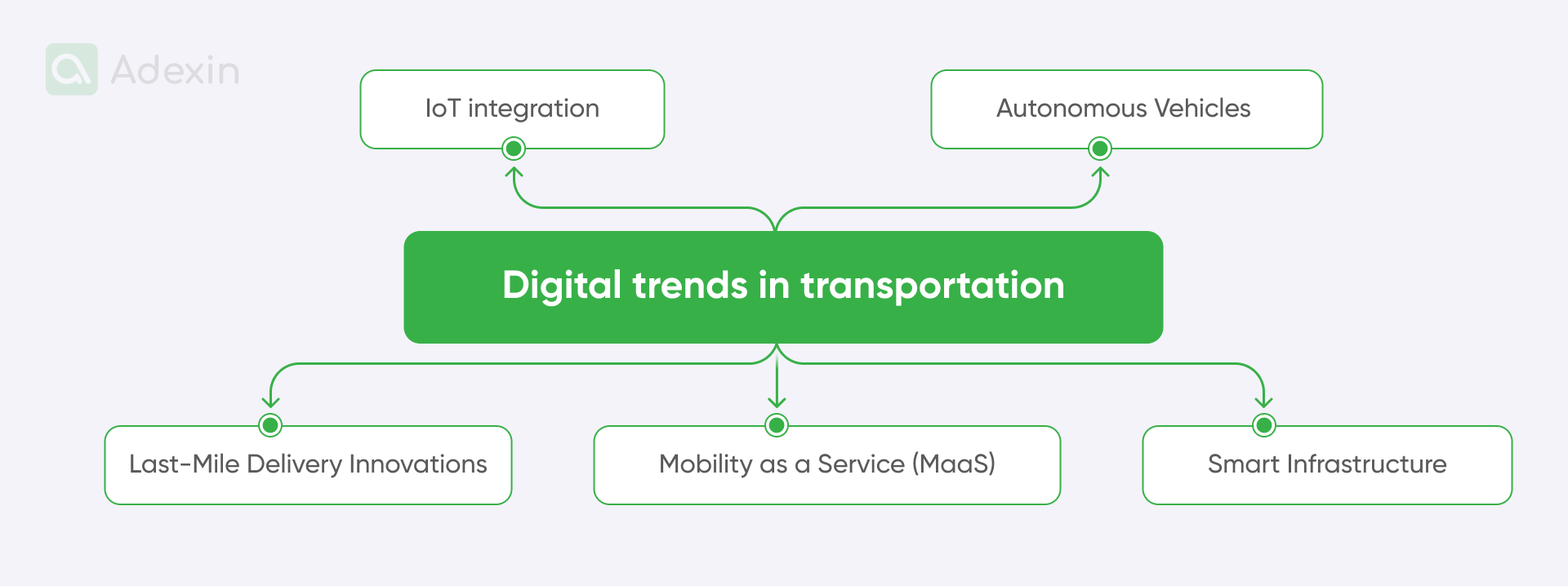
The transportation industry is undergoing a significant digital transformation driven by rapid technological advances and changing consumer behavior. This transformation presents numerous trends and opportunities that could transform the transportation industry as we know it. Here are some key trends and opportunities for digital transformation in transportation:
1. Interconnected vehicles and IoT integration
Connected vehicles equipped with sensors and Internet connectivity are becoming a standard in modern transportation. Such vehicles can communicate with each other, with infrastructure, and with central control systems. This connectivity improves traffic management, enhances safety with collision avoidance systems, and provides real-time data for better decision-making. [2]
2. Autonomous Vehicles and Automation
Autonomous vehicles, or self-driving cars, are at the forefront of transportation innovation. While fully autonomous vehicles are still in the testing phase, automation is already being integrated into various transportation modes, such as automated drones, trucks, and trains. This trend has the potential to revolutionize logistics and last-mile delivery. [1]
3. Mobility as a Service (MaaS)
MaaS is a concept that offers a seamless and integrated transportation experience. Through a single digital platform, users can plan, book, and pay for various transportation modes, such as buses, trains, ride-sharing, and more. MaaS promotes sustainable transportation choices and reduces traffic congestion. [3]
4. Smart Infrastructure and Traffic Management
Smart traffic management systems use real-time data to optimize traffic flow, reduce congestion, and enhance road safety. Intelligent traffic lights, adaptive traffic control algorithms, and smart signage are some examples of this trend. [1]
5. E-commerce and Last-Mile Delivery Innovations
The growth of e-commerce has spurred innovation in last-mile delivery. Drones, delivery robots, and autonomous vehicles are being explored to expedite deliveries and enhance customer experiences. [1]
What are the business opportunities for digitalization in transportation?
Digital transformation in transportation represents a promising landscape of opportunities. With the aforementioned integration of advanced technologies such as autonomous vehicles, intelligent traffic management systems, and mobility as a service (MaaS), the transportation industry has the potential for significant improvements. These innovations can lead to a variety of benefits that can affect overall performance [3]:
The digital transformation in transportation is a dynamic and evolving landscape, offering significant potential for industry players, entrepreneurs, and governments to shape the future of transportation systems and revolutionize how people and goods move from one place to another. [3]
What are examples of digital transformation in transportation?
Digital transformation is a key force in transforming transportation across different industries. In the London rail public transport industry, for instance, the Oyster card system has transformed commuting in the city, allowing passengers to seamlessly use buses, trains, and subways with a single contactless card. On the commercial front, companies such as Uber have disrupted traditional cab services by using mobile apps to hail rides, changing the way people travel. In a more recent example, DHL's use of IoT devices and real-time tracking software in logistics operations demonstrates how digitization is increasing supply chain visibility and efficiency.
Looking at Lantronix’s PoE+, which are power-over-Ethernet Switches, that provide power and remote access to more than 10,000 traffic intersections in New York City. This is what we can really emphasize as quite decent! The NYDOT, for years now, can remotely collect vital traffic information needed to monitor trends and improve service as well as assess safety needs.
Another case from this segment is about technology deployment in Northern New Jersey, where Verizon operates more than 4,000 service vehicles. Managers over there are using Networkfleet to pinpoint the exact location of vehicles before sending mechanics out to get them.
Obviously, we couldn’t miss development related to mobile apps and how important role these play for the transportation industry. Having direct experience in the transportation industry, we have also had many cases where we supported the supply chain. We have developed a mobile app for truck drivers that has completely changed business operations in a transportation company. Benefits such as better time management and digital document handling are only a small glimpse of how mobility is changing the industry.
Also, starting from Last-Mile delivery, we can mention that FIDELITONE successfully integrated with a company’s ERP to create real-time visibility through the FIDELITONE Partner Portal. FIDELITONE is a 3PL Order Fulfilment and Last Mile Delivery that takes care of inbound logistics and other processes in the supply chain. They’ve implemented customer surveys and a weekly scorecard to keep a pulse on performance and satisfaction. This turnkey solution addressed every aspect of last-mile delivery and helped track better processes all over the network.
The next example is coming with autonomous vehicles and automation. Significant investments were made in 2010 to transform basic work units into robust, highly available, fault-tolerant, and cost-effective products for the market. This long incubation period was necessary to ensure safety, robustness, and service performance in the US market. Some solutions have achieved regulatory, public, and industry acceptance and require comprehensive safety validation. But it wasn’t so easy. What happened between 2017-2018 after an Uber robo-taxi prototype in Arizona collided with and killed a pedestrian, has led to strengthened restrictions in development. Moreover, several Tesla drivers were killed while using the AutoPilot feature, and there wasn’t any exception for Tesla cars.
These incidents highlighted the challenges of shared human-machine control and underscored the need for fully automated vehicles. However, there are still many advances on the way, such as Ford, which is testing robo-taxis in several U.S. cities. They launched a limited ADS fleet in 2021 in Miami, Washington DC, and Austin.
Another case where the tests are on the way is Waymo. They’re operating a fleet of around 600 AVs, mainly in Phoenix, and partnering with UPS for local package movement. Moreover, other businesses, such as Walmart and Domino’s Pizza are testing autonomous grocery delivery in Houston with NURO.
Today we have many more examples underscore how companies are leading the way in using digital technologies to redefine transportation standards that are bringing a major shift in transportation worldwide.
Digital transformation in logistics and transportation
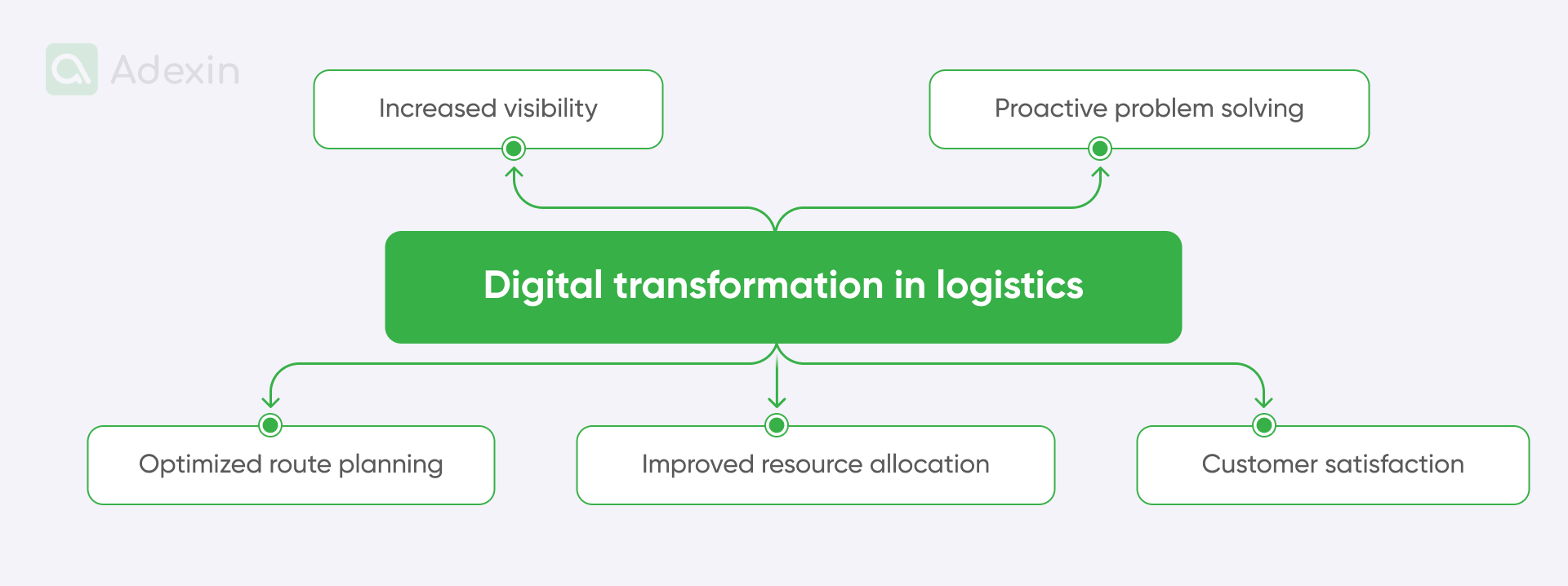
A great illustration of digital transformation in the logistics industry is the business of DHL, a well-known global logistics company. DHL has used cutting-edge digital technologies to redefine the way it manages and optimizes its logistics processes. The digital transformation initiative included the implementation of IoT (Internet of Things) and predictive analytics, simultaneously providing significant benefits to the logistics industry and DHL itself:
Increased visibility
By integrating IoT sensors into shipments, DHL can provide real-time visibility into the location, status, and condition of goods throughout the supply chain, enabling customers to accurately track shipments. [4]
Proactive problem solving
With predictive analytics, DHL can anticipate potential disruptions or delays in the supply chain and take preventive measures to mitigate risks, ensuring timely and efficient deliveries. [4]
Optimized route planning
DHL uses data analytics to analyze historical and real-time traffic data, enabling optimal route planning for its fleet of vehicles. This reduces delivery times and fuel consumption.
Improved resource allocation
DHL's digital transformation has led to more efficient allocation of resources, such as vehicles and manpower, based on demand patterns and operational needs, thereby increasing overall efficiency. [4]
Customer satisfaction
The transparency and accuracy facilitated by DHL's digital solutions have significantly improved customer satisfaction by providing timely updates, reducing delivery errors, and offering personalized delivery options. [4]
Digital transformation in public transport
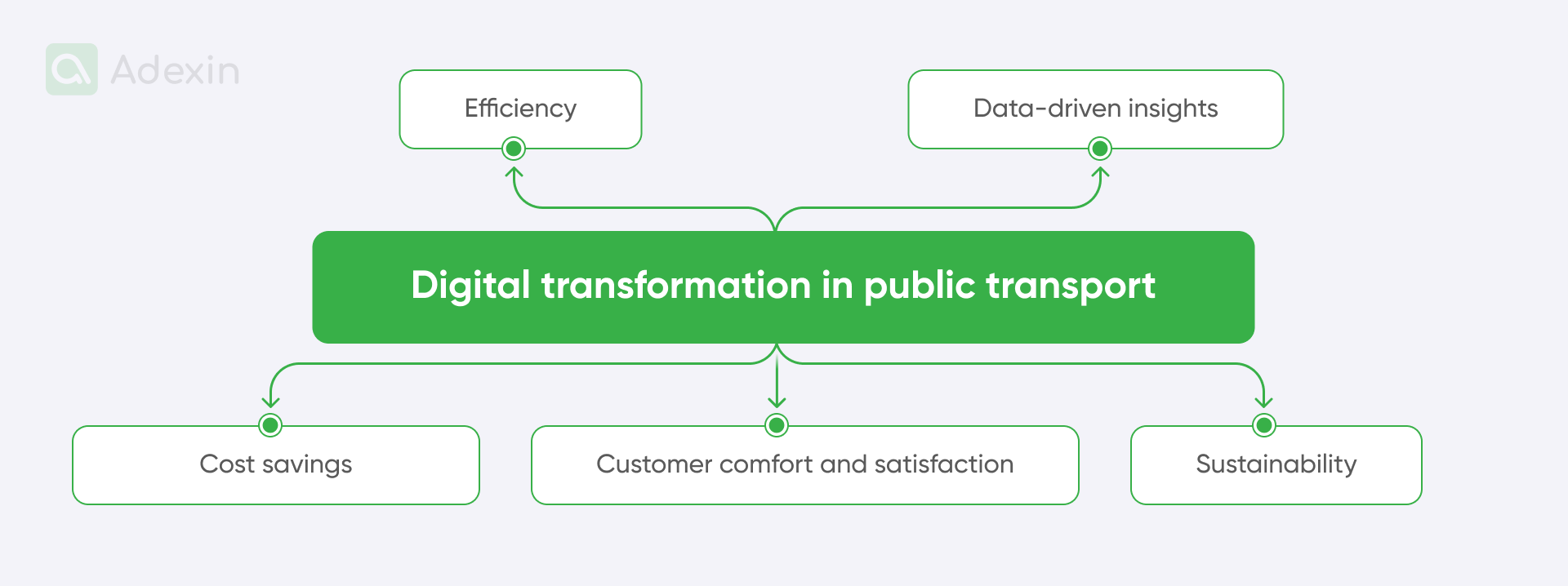
A clear example of digital transformation in the transportation industry is London's Oyster card system. By implementing this contactless payment system on various public transportation modes, Transport for London (TfL) has experienced several notable benefits:
Efficiency
The Oyster card eliminates the need for paper tickets, streamlining the passenger boarding process and reducing the time spent on ticket transactions.
Data-driven insights
The system collects valuable data on travel patterns, peak hours, and popular routes. TfL can analyze this information to optimize schedules, efficiently allocate resources and plan future infrastructure improvements.
Cost savings
Oyster cards offer discounted fares compared to single paper tickets, encouraging passengers to choose more economical travel options. This encourages more frequent card use and helps reduce cash-handling expenses.
Customer comfort and satisfaction
Passengers enjoy hassle-free travel as they can easily reload their Oyster cards online or at various kiosks. This convenience encourages more rides and increases customer satisfaction.
Sustainability
By reducing reliance on paper tickets and streamlining operations, the Oyster card contributes to less paper waste and a greener transportation system, aligning with broader sustainability goals. [5]
Digital transformation in commercial transportation
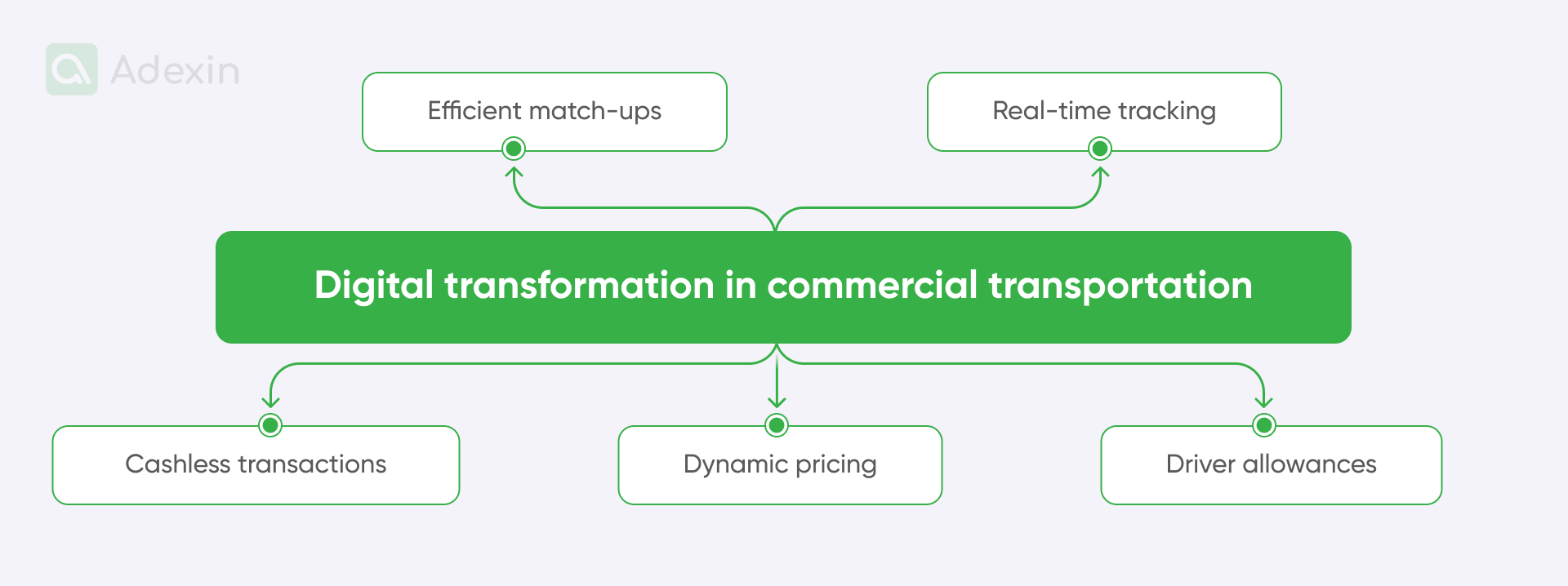
A key example of digital transformation in commercial transportation is Uber, the ride-sharing giant. Uber's innovative platform has brought several significant benefits to the industry:
Efficient match-ups
Uber's app effectively connects drivers with passengers based on location, reducing driver idle time and minimizing passenger waiting time.
Real-time tracking
Passengers can track the location of their assigned vehicle in real-time, increasing transparency and providing a sense of security.
Cashless transactions
Uber's digital payment system eliminates the need for cash transactions, providing a smooth and secure payment experience for both drivers and passengers.
Dynamic pricing
Uber's pricing model adjusts fares based on demand, encouraging more drivers to be available during peak hours and balancing supply with demand.
Driver allowances
The platform offers drivers flexibility, allowing them to work on their own terms. This opportunity has attracted a diverse pool of drivers, increasing the availability of transportation options. [3][6]
Are you in search of a reliable tech partner?
Adexin can help with advanced logistics solutions
Contact usProgressive use of digital technologies in transport services
The transportation industry is in the midst of dynamic change while various advances are transforming its landscape. From the use of predictive analytics to optimize routes to the integration of intelligent fleet management systems, the industry is undergoing a transformation. The emergence of connected vehicles, autonomous driving, and the concept of mobility as a service (MaaS) is shifting our perception of traffic. Furthermore, the explosive growth of e-commerce is driving innovative last-mile delivery strategies. At the same time, the deployment of smart infrastructure and traffic management systems is increasing both efficiency and safety.
These steps mark a key shift in transportation, offering stakeholders unparalleled prospects for redefining the transportation of goods and people in our interconnected world. Beyond the public sector, the wave of digitization in the transportation industry is expanding its significant impact on overall supply chain efficiency.
Footnotes:
[1] BVL (2017). "Trends and Strategies in Logistics and Supply Chain Management – Digital Transformation Opportunities, Bremen, 2017." Retrieved from: https://www.bvl.de/misc/filePush.php?id=39660&name=BVL2017-TAS-Digital-Transformation-Study.pdf
[2] The British University in Dubai (2021). "MSc INFORMATION TECHNOLOGY MANAGEMENT - The British University in Dubai - November 2021." Retrieved from: https://bspace.buid.ac.ae/buid_server/api/core/bitstreams/4b07e4e0-3eef-4d8f-bda4-777c4f90eea7/content
[3] Ministry of Infrastructure and Water Management in The Netherlands. "The impact of digitalisation on the access to transport services: A literature review." Retrieved from: https://www.researchgate.net/publication/342735768_The_impact_of_digitalisation_on_the_access_to_transport_services_a_literature_review

